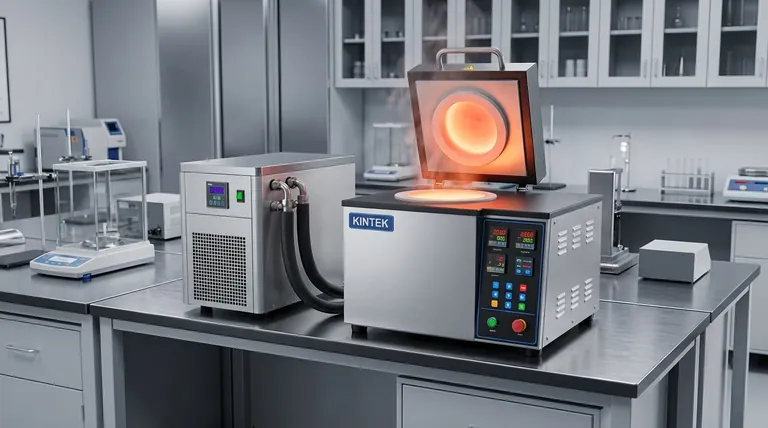In short, induction heating is not defined by a single temperature. Instead, its temperature is highly controllable and can be adapted to the specific task, capable of reaching 1800°C (3272°F) or even more in specialized furnace applications. The final temperature depends entirely on the material being heated, the power applied, and the design of the induction system.
The core principle to understand is that induction heating generates heat inside the object itself through electromagnetic principles. This internal heating method provides exceptional speed and control, allowing for a vast temperature range from gentle warming to melting the toughest metals.

How Induction Heating Generates Extreme Temperatures
Induction heating doesn't rely on an external flame or heating element. The process is far more direct, converting electrical energy into heat within the material itself. This is what allows for such rapid and precise temperature control.
The Core Principle: Electromagnetic Fields
An induction heating system uses a powerful alternating current (AC) flowing through a specially designed coil. This current generates a dynamic and intense magnetic field in the space around the coil.
Inducing "Eddy" Currents
When a conductive material, such as a metal part, is placed within this magnetic field, the field induces electrical currents within the part. These circulating currents are known as eddy currents.
The Joule Effect: From Current to Heat
The material being heated has a natural resistance to the flow of these eddy currents. This resistance creates friction, which generates intense heat directly inside the part—a phenomenon known as the Joule effect. It is this internal heat generation that can raise the temperature of the material to its melting point and beyond.
The Advantages of the Induction Method
Because heat is generated internally rather than being applied externally, induction heating offers several distinct advantages over traditional methods. These benefits are directly linked to its unique operating principle.
Unmatched Speed and Precision
Since heat is generated inside the object, the heating process is incredibly rapid and efficient. There is no need to wait for heat to conduct from an external source to the core of the part.
A Clean, Non-Contact Process
The heating coil never touches the part being heated. Heat is transferred via electromagnetic waves, which means there is no risk of contamination from a flame, combustion byproducts, or contact with a heating element.
Environmental Responsibility
Induction heating is a "green" technology. It does not produce harmful emissions, and since it only heats the target material, it avoids wasting energy by heating the surrounding atmosphere. This makes it a highly efficient and environmentally friendly choice.
Making the Right Choice for Your Goal
Understanding the capabilities of induction heating allows you to determine if it is the correct technology for your specific manufacturing or treatment process.
- If your primary focus is rapid, high-temperature applications: Induction heating is an excellent choice for melting metals, forging, or heat-treating parts that require quick and intense thermal cycles.
- If your primary focus is process purity and control: This method is ideal for medical, aerospace, or electronics applications where product contamination from external sources is unacceptable.
- If your primary focus is efficiency and environmental impact: Choose induction for a clean, non-polluting process that minimizes wasted energy and provides a safer working environment.
Ultimately, induction heating offers a level of control and efficiency that few other thermal processes can match.
Summary Table:
| Key Aspect | Details |
|---|---|
| Temperature Range | Highly controllable, from gentle warming to 1800°C (3272°F) and beyond |
| Heating Method | Internal heat generation via electromagnetic induction (eddy currents & Joule effect) |
| Primary Advantages | Unmatched speed, precision, non-contact process, and environmental friendliness |
| Ideal For | Melting, forging, heat treatment, and applications requiring purity and control |
Ready to harness the power of precise, high-temperature induction heating for your lab or production line?
KINTEK specializes in advanced lab equipment, including induction heating systems designed for efficiency, control, and purity. Whether you're melting metals, heat-treating components, or require a contamination-free process, our solutions deliver the speed and precision you need.
Contact our experts today to discuss how induction heating can transform your operations!
Visual Guide

Related Products
- Lab-Scale Vacuum Induction Melting Furnace
- 1400℃ Laboratory Quartz Tube Furnace with Alumina Tube Tubular Furnace
- 600T Vacuum Induction Hot Press Furnace for Heat Treat and Sintering
- Vacuum Heat Treat Furnace and Levitation Induction Melting Furnace
- 1800℃ Muffle Oven Furnace for Laboratory
People Also Ask
- What are the advantages of vacuum induction melting? Achieve Ultimate Purity & Precision for High-Performance Alloys
- What is VIM in metallurgy? A Guide to Vacuum Induction Melting for High-Performance Alloys
- What is vacuum induction melting used for? Creating Ultra-Pure Metals for Demanding Industries
- What are the advantages of induction melting? Achieve Faster, Cleaner, and More Controlled Metal Melting
- How does a vim furnace work? Achieve Ultimate Purity in High-Performance Metal Melting



















